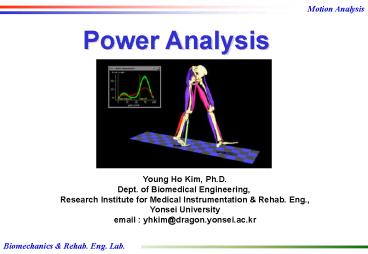Power Analysis PowerPoint PPT Presentation
1 / 14
Title: Power Analysis
1
Power Analysis
Young Ho Kim, Ph.D. Dept. of Biomedical
Engineering, Research Institute for Medical
Instrumentation Rehab. Eng., Yonsei
University email yhkim_at_dragon.yonsei.ac.kr
2
Energy and power during the gait cycle
- Power is Energy / time, the rate at which energy
is - created (positive power)
- or absorbed (negative power)
- Structures in the body that can generate or
absorb energy include - muscles
- other soft tissue
- Power is measured in Watts or Joules/sec.
3
Mechanical Power
Power Moment or Torque ? Angular Velocity
P M??
or
1. Concentric Contraction - Angular
velocity and joint moment are in the same
direction. - Positive work of muscles -
Power or energy generation
Forearm extension Extension moment
Forearm flexion Flexion moment
4
2. Eccentric Contraction - Angular
velocity and joint moment are in the opposite
direction. - Negative work of muscles -
Power or energy absorption
Forearm extension against flexion moment
Forearm flexion against extension moment
5
Sequence of Events During Simple Extension and
Flexion of Forearm
Net Moment
Angular Velocity
Muscle Power
-
-
6
Muscle Power (Ankle)
- Two distinct roles of the plantarflexors during
stance - Small eccentric contraction of the dorsiflexors
(tibialis anterior and the peronei) immediately
after IC to control the foot - Their concentric contraction to lift the foot
during swing
7
Power at the hip, knee and ankle during normal
gait
- Power is positive when the body generates energy
through concentric muscle activity. - Power is negative when the body absorbs energy
through eccentric muscle activity or elongation
of soft tissue. - SAS program that produced these graphs
- How joint power is calculated
8
POWER CURVE FOR THE ANKLE JOINT
- A1 a region of negative power, corresponding to
eccentric plantar flexor activity at the ankle
during Mst and Tst. - A2 a region of positive power, corresponding to
the concentric burst of propulsive plantar flexor
activity during Psw.
9
POWER CURVE FOR THE KNEE JOINT
- K1 negative power, corresponding to eccentric
knee extensor activity (quadriceps) at during LR.
- K2 positive power, corresponding to concentric
knee extensor activity during Mst. This is
followed by a period of negligible joint power
during that period of time when the ground
reaction force stabilizes the knee in extension. - K3 negative power, corresponding to eccentric
activity in the rectus femoris during Psw. At
normal or slightly faster walking speeds, rectus
femoris controls knee flexion. - K4 negative power, corresponding to eccentric
activity in the hamstrings during Tsw
10
POWER CURVE FOR THE HIP JOINT
- H1 a small region of positive power, not always
present, which corresponds to concentric hip
extensor activity during LR. - H2 negative power, corresponding to eccentric
hip flexor activity during Mst - H3 positive power, corresponding to concentric
activity in the hip flexors during Psw and Isw.
Sometimes called "pull off," this is the muscular
system's second largest contribution of
propulsive power during the gait cycle.
11
CALCULATION OF JOINT POWER
- joint angle
- The first curve's slope at any point in the gait
cycle reflects the joint's angular velocity (w). - joint moment (M)
- joint power (P)
- PMw
12
- Power can be a negative or positive quantity
- When the muscle moment of force (M) and the
direction of joint movement (w) are the same at a
particular joint - positive power
- energy is generated by concentric action in
muscles crossing that joint. - When M and w are in opposite directions
- negative power
- energy is absorbed in eccentric muscle action
and/or elongation of other soft tissue crossing
the joint.
13
(No Transcript)
14
(No Transcript)

